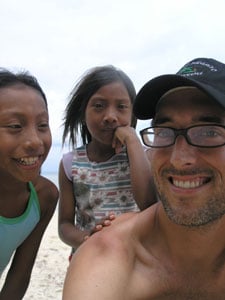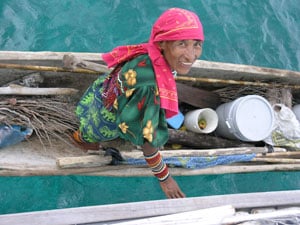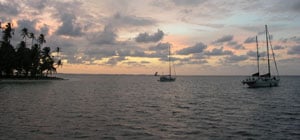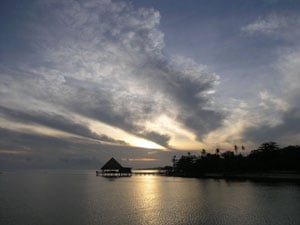Kate & Rob
Connections Discovered in Kuna Yala
Hand-in-hand we circled the shoreline of Gunboat Island once again, laughing while stutter-stepping to playfully throw off the focus of the two little Kuna girls following close behind and diligently retracing our every step. In this improvised game of the tropical Pied Piper, the girls created their own tiny prints within each of our sandy, cavernous outlines.
If we walked faster, they ran desperately to keep pace. If we side-stepped into the bathtub-clear water, they screamed in mock-fear that the impending cave-in might wash away our sketch before their impending masterpiece. The girls’ rapt attention could easily be brought to a screeching halt, as now and then we would hit the brakes, resulting in a hysterical pile-up on the scale of Mini Coopers colliding into armored Hummers.
Smash-ups and ominous names aside, we saw no other disturbance of the peace during our brief time on Gunboat Island, an idyllic Caribbean speck and single-family residence off the eastern coast of Panama. Indeed, despite language and cultural barriers, we were quickly in accord with the spirit of the place and its inhabitants.
We shared each other’s names by drawing in the sand. Our bilingual playmates, Elaida and “A.” (the shy, younger sister), mercifully spoke to us in Spanish rather than Kuna, dumbing down their own proficiency to our nascent level. And like our niece and nephews, these schoolchildren – who paddle the sea in a dugout canoe well over an hour each way to reach the nearest island with a school – loved the game of helicopter. The moment I gently brought one down to earth onto our soft, white, particulate landing pad, the other was waiting with outstretched arms to spin and take flight.
Kate and I, too, were aloft in the stratosphere.
Land of the Kunas
Our love of Central America and its proximity to our home in Texas eventually led us to honeymoon in Kuna Yala (“the land of the Kunas”), from April 16-24, 2007. During the winter months before, while still considering other warm, beach destinations in Central America, we learned about this unique Panamanian archipelago.
Comprised of nearly 400 mostly uninhabited coral islands and a strip of mainland that extends about 200 miles west-northwest from the Colombian border, Kuna Yala is also commonly known by its colonial name, the San Blas Islands. Operating their ancestral land as a semiautonomous zone in Panama since 1925, the indigenous Kuna people have managed to cling to their vibrant culture and limit western influence by not allowing foreigners to own land or run hotels.
We realized experiencing this independent, indigenous culture in what the guidebooks and Internet promised to be a Robinson Crusoe-esque, postcard-perfect paradise was an opportunity not to be missed. Especially when we learned our love of adventure could be satiated by a new experience for us – sailing (and amongst coconut palm-covered deserted islands, no less!).
But we still had to deal with practicalities (i.e., finances). We normally pride ourselves on being independent, budget travelers. And this proposed honeymoon was so utterly beyond the realm of backpacks and hostels! While we wanted to do something luxurious for this once-in-a-lifetime occasion, we still had a hard time being comfortable with the astronomic price tag.
Until we discovered Traveler’s Joy. Through the Web site, our friends and family contributed $1,020 which, when combined with other monetary wedding gifts and our frequent flyer miles, covered almost all of the nearly $4,000 total.
A Prescient Gaze
Most travelers reach Kuna Yala on a once-daily domestic flight from Panama City that, like a city bus, follows a route to several airstrips throughout the archipelago. Our stop was El Porvenir, a small island with one hotel and about 500 inhabitants.
One of them is Charlie, an old, retired Kuna man who used to work at a hotel in Panama City, where he learned some basic English. He now spends his days hanging out with friends who own the Hotel San Blas, where we ate breakfast and settled in for a wait.
Our final destination for the day was the Coral Lodge, an eco-resort located about eight miles west of the Kuna Yala boundary. Because of its remote location that is only reachable by an hour-long boat ride, the lodge usually only picks up guests once a day as part of a cultural/snorkeling tour that begins in the early morning when the plane arrives. Due to the hefty additional price for the tour and the fact that we would be doing similar activities during the latter sailing half of our trip, we declined, opting to spend a few hours on the El Porvenir beach until the lodge could send another boat in the early afternoon.
We passed some of that time with Charlie. When he learned we were on our honeymoon, a knowing smile stretched across his face. Gazing pensively across the sea in the direction of a distant palm-tree skyline, he slowly muttered, “Ah, luna de miel en Kuna Yala…”
Unwinding in Style
Hardly any time passed before we were found basking in the splendor of sun and white sand by Laurie, who manages the Coral Lodge with fiancé, Rob. (Like us, this young American couple – probably mid-to-late 20s – travels the backpacker circuit, but ended up in their luxurious locale after spending time teaching English and studying eco-tourism in Costa Rica.) It was mid-morning, and Laurie had come back to El Porvenir after dropping off guests at a nearby island for the cultural stop on their tour. In what was the first of many kind and generous acts, Laurie allowed us to tag along for the rest of the tour.
It was phenomenal. En route to the island of Wailidup, our snorkeling destination, we passed unspoiled islands where Hawaiian Tropic and Playboy shoot. And the perfection above-ground was matched below the surface offshore. I’m sure I’ll be forever spoiled by that first experience of snorkeling. I was awestruck by the exploding technicolor of alien coral landscapes and fishes.
Our three days at the Coral Lodge were equally surreal and pampered. We stayed in one of six thatched-roof huts that jut out from the mainland over the turquoise waters of a small bay filled with its own spectacular coral reefs. From our back, private balcony we could while away the days in a chaise lounge or hammock, or dive in for a swim or snorkel around the bay.
Other activities we enjoyed there were walks in the rainforest with lush, overblown plants all around and howler monkeys bellowing overhead; kayaking into a green heart of darkness on a winding, caiman-inhabited trail to the interior; sea kayaking the opposite direction through mangroves, obstacles of shallow coral reef and swelling waves; and sharing tropical cocktails on the beach during a magical Caribbean sunset.
The all-inclusive lodge has its own truly gifted chef, who created real wonders with the local food stuffs (mostly fish, fruit and some organic veggies from a garden they managed to create in spite of the soil, or rather sand).
Although not used to such luxury, we quickly learned to appreciate the way things are done by the other half. It was the perfect way to unwind from months of stress induced by wedding planning – something any honeymooners can relate to.
Our last night at the lodge was truly special. After a final, amazing dinner, unbeknownst to us, we were stalled in conversation by other guests while Laurie and Rob laid out a surprise. We returned to our bungalow to find a candlelit, romantic room and chilled champagne, a last indulgence and generous memory.
Adventure (and Inspiration) Found
Our next four days were spent onboard the Roxy, a 50-foot yacht owned by retired Swedish couple, Christina and Ulf. When we booked the chartered trip through San Blas Sailing, we were lured by the adventure and romance of the sea.
But in the decompressing days following our wedding, we prepared to embark on our maiden sailing voyage with a bit of apprehension and a lot of questions. Would the accommodations be too primitive? Would the vessel just be a floating RV? Could the experience possibly compare to the extravagance of the Coral Lodge? What would the shower and toilet be like? What if we couldn’t relate to the couple at all? And last, but not least – would there be any privacy? (After all, this was our honeymoon….)
It could have been a long four days. But, fortunately, our concerns were unfounded.
Christina and Ulf were remarkable. And the Roxy had incomparable charm, with plenty of space. Most importantly, she took us to unforgettable places and people in Kuna Yala.
We took to the sailing life immediately. The gentle pulse of the sea, salty breath of the air and omnipresent gaze of the sun were invigorating. On the first morning, I discovered the greatest waking ritual: a rousing dive into the sea for a brisk solo swim, followed by several contemplative minutes alone on deck, drying off and taking in the world, before partaking in the nourishment of fresh juice, coffee and conversation.
Our talks with Christina and Ulf over meals were some of the best moments we experienced. On some level, we provided a generational link to the thoughts and issues of their own children, who are about our age, but flung across the globe in England and Australia.
And Christina and Ulf were an inspiration to us newlyweds – an example of a long-lasting, loving partnership and the commitment to a dream. After retiring a couple years ago, they had rented out their home in Sweden, bought the Roxy and were now living the improbable notion of sailing the world. Having spent some time in other parts of the Caribbean before discovering Kuna Yala, they fell in love with the place and decided to linger. They were doing the charters for now, but planned to move on at some point, probably toward Australia and a new grandson.
During our four days with them, they showed us many stunning places, including Ulf’s favorite snorkeling spot in the Cayos Coco Bandero, a remote grouping of pristine islands. We also snorkeled the shallow waters offshore Dog Island through dense coral growing on a World War II-era shipwreck.
But we most appreciated them for sharing Kuna culture with us. Their openness, warmth and months spent amongst the people in the region had been reciprocated by true friendships.
On the isle of Cartí, we hung out with their friend, Mr. G, an enigmatic, fun-loving character caught between cultures. Mr. G learned English in Salt Lake City, where he spent a few youthful years after converting to Mormonism (he had since gone back to his Kuna religion because, as he put it, “I like the beer.”) He proudly invited us into his dirt-floor home, shared his religious icons, guided us through the thatched-roof maze of his community and introduced us to his friends.
Back onboard the Roxy, we were often visited by merchants Christina and Ulf knew. They would paddle up to sell mangoes or the catch of the day out of their dugout canoes, and Ulf would take their cell phones to charge overnight since most Kuna have no electricity.
Early one evening, we were able to peruse and purchase molas (embroidered works of art that traditionally are panels on a Kuna woman’s blouse) from a couple in such a dugout. Christina and Ulf knew Priciliano and Adelaida and invited them onboard. Though our conversation was limited, we overcame the language barrier with hospitality, drinks and laughter. That exchange led to our invitation to Gunboat Island.
Circling the islet the next day, I concluded it was roughly the size of the quarter-mile track I used to run during high school. On this dot, in a setting many would consider paradise, three generations of a family live in a culture so foreign to us it is almost unknowable.
The entire family (over 10 members) lives in two huts that are each the size of one of our bedrooms. The floors are sand. There is no electricity. During the day, clothes hang from the thatched ceiling where hammocks drape at night. Meals are caught, gathered or traded to be prepared over an open flame. An outhouse sits at the end of a pier.
But, as we had learned throughout our time in Kuna Yala, cultural differences only run so deep. The spellbound children who had followed two giant, pale Pied Pipers around their lot were equally enchanted by their own digital images in my camera. And like our niece and nephews, they wanted to take photos. I happily let them shoot several, and they squealed in delight.
Elaida and A. captured their toddler brother, his kitten, each other – and us.






